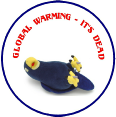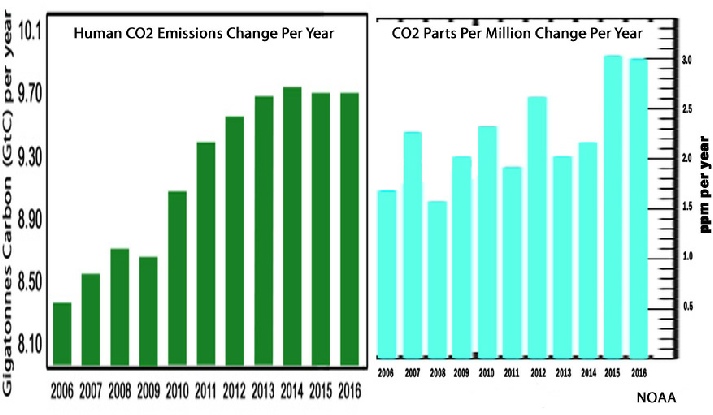Debunking the Climate Scam
Billions of Dollars -
Greedy Green Corporations -
No Warming For Two decades -
Bought and Paid For Organizations

5000 Years Of Climate Change From Greenland Ice Cores

Many Peer Reviewed Papers Show CO2 FOLLOWS Temperature
Since a cause cannot follow an effect, CO2 DOES NOT cause warming.
From:
Evidence Review Suggests Humans May Not Be The Primary Drivers Of CO2 Concentration Changes
By Kenneth Richard on 29. June 2017
Anthropogenic Emissions ≠ CO2 Concentration Changes
For the last 3 years, human CO2 emissions rates have not risen. In fact, according to the IEA, we burned slightly more fossil fuels in 2014 than we did in both 2015 and 2016.
Despite the lack of growth – even slight decline – in human emissions rates during 2014 – 2016, the atmospheric CO2 parts per million (ppm) concentration grew rapidly – by more than 8 ppm (397 ppm to 405 ppm).
This lack of compatibility between year-
Munshi, 2015
“A necessary condition for the theory of anthropogenic global warming is that there
should be a close correlation between annual fluctuations of atmospheric CO2 and
the annual rate of anthropogenic CO2 emissions. Data on atmospheric CO2 and anthropogenic
emissions provided by the Mauna Loa measuring station and the CDIAC in the period
1959-
-
A user-

-
A Strong Lead-
It has long been recognized by atmospheric scientists that temperature changes are
drivers of CO2 concentration variability. This is especially due to the physical
observation that oceans – which have 50 times more dissolved CO2 than the atmosphere
does – release more of their vast stores of CO2 during warm years, and they retain
more CO2 during anonymously cool years. For example, Flohn (1982) observed that
the oceans contribute almost twice as much to the CO2 concentration change during
warm-
Flohn, 1982
“The recent increase of the CO2-
“Comparative investigations (Keeling and Bacastow 1977, Newll et al. 1978, Angell
1981) found a positive correlation between the rate of increase of atmospheric CO2
and the fluctuations of sea surface temperature (SST) in the equatorial Pacific,
which are caused by rather abrupt changes between upwelling cool water and downwelling
warm water (“El Niño”) in the eastern equatorial Pacific. Indeed the cool upwelling
water is not only rich in (anorganic) CO2 but also in nutrients and organisms. (algae)
which consume much atmospheric CO2 in organic form, thus reducing the increase in
atmospehreic CO2. Conversely the warm water of tropical oceans, with SST near 27°C,
is barren, thus leading to a reduction of CO2 uptake by the ocean and greater increase
of the CO2. … A crude estimate of these differences is demonstrated by the fact that
during the period 1958-
-
In the undergraduate-
“Warming of SST (by any mechanism) will increase the outgassing of CO2 while reducing its absorption. Owing to the magnitude of transfers with the ocean, even a minor increase of SST can lead to increased emission of CO2 that rivals other sources.” pg. 546
“The results for the two periods are in broad agreement. Together with the strong dependence of CO2 emission on temperature, they imply that a significant portion of the observed increase in r˙CO2 derives from a gradual increase in surface temperature.” pg. 253
“Surface temperature depends on the atmosphere’s optical depth. The latter, in turn, depends on atmospheric composition through radiatively active species. Water vapor is produced at ocean surfaces through evaporation. Carbon dioxide is produced by decomposition of of organic matter. These and other processes that control radiatively active species are temperature dependent.” pg 249, 250
“Together, emission from ocean and land sources (∼150 GtC/yr) is two orders of magnitude greater than CO2 emission from combustion of fossil fuel. These natural sources are offset by natural sinks, of comparable strength. However, because they are so much stronger, even a minor imbalance between natural sources and sinks can overshadow the anthropogenic component of CO2 emission.” pg. 546
Read much more at the source: http://notrickszone.com/2017/06/29/evidence-
MORE:
| Warming Stopped |
| NOAA Data |
| NorthWest |
| Oregon |
| Washington |
| Extreme Weather |
| Past Was Warmer |
| NASA: 30's Hotter |
| HistoryOFAlarmism |
| Central England |
| Temperature History |
| MultiProxy |
| treemometers |
| Northwest Passage |
| Acidification-Ball |
| Acidification-Fulks |
| Acidification-Idso |
| Selected Emails |
| CRU Emails - html formatted |
| CRU Emails Simple Format |
| CRU Emails UnFormatted |
| DCPS paper |
| CRU_Files_Notice |
| False Deadlines |
| Hockey Stick Links |